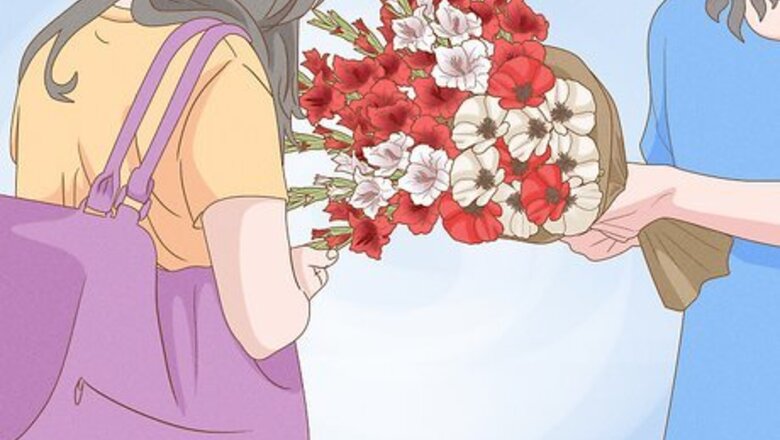
views
- The gladiolus is a tall, showy flower that’s named after the Latin word for sword. It symbolizes strength, honor, infatuation, and faithfulness.
- The poppy is known for its delicate, colorful petals and sedative effects. It represents remembrance, sleep, death, and imagination.
- Red gladioli symbolize romance, pink indicates compassion, and yellow signifies happiness. Red poppies symbolize commemoration while orange poppies represent joy.
The Birth Flowers for August

The gladiolus and the poppy are the birth flowers for August. Both the gladiolus and the poppy grow their intense, bright blooms in the heat of the summer, making them the perfect flowers for people born in August. These colorful flowers are popular in bouquets and look beautiful together, so they’re a great gift for anyone with an August birthday!
What does a gladiolus look like?
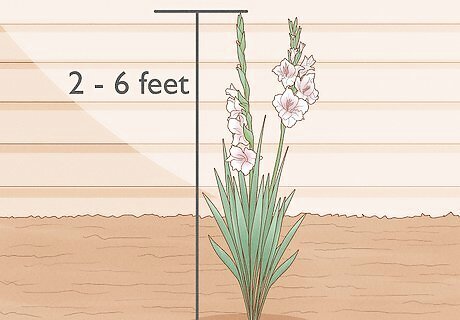
The gladiolus flower grows from tall, sword-like stems. The gladiolus gets its name from the Latin word gladius, which means “sword.” The showy, frilly flowers on the gladiolus grow in bunches at the very top of their stems and are surrounded by spiky leaves. You’ll find blooms in almost every color under the sun, including brilliant pinks, cheerful yellows, majestic purples, and serene whites. The gladiolus is often called the sword lily, even though it is more closely related to the iris than the lily. Gladioli can grow between 2 to 6 feet (61-183 cm) tall!
Gladiolus Symbolism

The gladiolus represents strength, honor, and intelligence. With the gladioli’s majestic flowers and hardy stems, it’s no wonder they’re associated with power and integrity. The tall blooms of the gladiolus represent your ability to face challenges, persevere through adversity, and come out on the other side victorious. Gladioli can also represent remembrance. They are often used in funeral and memorial arrangements to emphasize the enduring legacy of a lost loved one.

Gladioli blooms also symbolize infatuation and love at first sight. In the Victorian Era, people developed floriography, a secret language where each type of flower held a different meaning. The gladiolus’ sword-like appearance was believed to pierce your beloved’s heart just like Cupid’s arrow, making them yours forever. The flower’s association with love at first sight and enchantment still remains today!

Gladiolus bouquets signify faithfulness. The blooms on the gladiolus stay bold and beautiful for weeks, so they're associated with enduring love, devotion, and loyalty. They are also the flowers traditionally given at a fortieth wedding anniversary, symbolizing long-lasting love.

Different gladiolus colors mean different things. The color of the gladiolus flower changes its message, making different blooms a more fitting gift to receive from a romantic or platonic relationship. For instance: Red gladioli symbolize romantic love, making them an extra special gift to receive from your partner on your birthday. Pink gladioli represent tender love and compassion for friends and romantic partners. They also represent a mother’s love and make a beautiful bouquet for Mother’s Day. Yellow gladioli signify happiness, joy, and friendship. They’re a great gift to give to your your best friend on their birthday. White gladioli represent purity, innocence, and new beginnings. They’re popular choices for August weddings. Purple gladioli symbolize beauty, charm, and grace. A friend might give you them to celebrate your successes while a date might hope to win you over with them.
Gladiolus History

Most gladioli originate from South Africa. The most striking and widely cultivated species of gladiolus come from South Africa, where the flowers were prized for both their beauty and their delicious taste. While gladioli also grew around the Mediterranean, Europeans were taken by the flowers in South Africa and brought them back in the 1700s, where they quickly gained popularity.
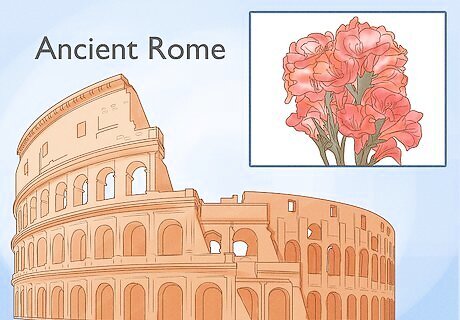
Gladiolus flowers were given to gladiators in Ancient Rome. Both gladiator and gladiolus come from the Latin word gladius meaning “sword,” so it’s no wonder they’re related. When a gladiator won their fight, Roman spectators would shower them with gladioli to celebrate their victory.
Growing Gladioli

Gladioli thrive in full sun and well-draining soil. If you want to grow gladiolus flowers in your garden, choose a spot that gets at least 6 hours of direct light. Simply plant and cover the gladiolus corms, which are a type of bulb, in the ground in the spring. Then, water the soil when it’s dry and wait for beautiful blooms to grow in the early summer. Gladiolus flowers are perennials, meaning they grow back year after year. Choose a gladiolus variety depending on the size and color of the flowers. For instance, gladiolus byzantinus grows large, pink blooms while gladiolus colvillei, or “The Bride”, grows delicate, white flowers. In the US, gladioli grow the best in USDA hardiness zones 8 through 10.
What does a poppy look like?
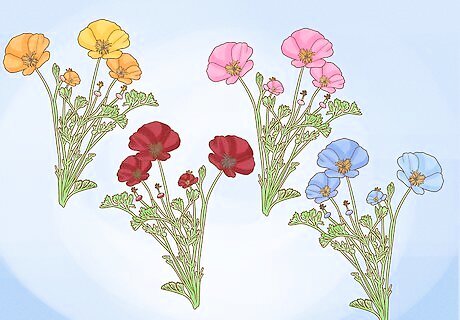
Poppies grow bold yet delicate flowers. Poppies are well-known for their sweet, wildflower-like appearance. They grow 4 to 6 crepe-like petals that come in deep reds, soft oranges, vibrant pinks, and brilliant blues. Different varieties of poppies grow all over the world, spanning from Asia to Europe and across North America.
Poppy Symbolism

The poppy symbolizes remembrance and memorial. Poppies are strongly associated with war and are used to honor soldiers who lost their lives in battle. The poppy was linked to remembrance during World War 1, as poppies sprang up on the deserted battlefields and over soldiers’ graves. John McCrae popularized the poppy as a commemorative symbol in his poem “In Flanders Fields.” Red poppies are typically used to honor soldiers on Remembrance Day all across the world.

Poppies also represent sleep and death. Some varieties of poppies produce opium, which is a narcotic substance that relieves pain and induces sleep. Ancient civilizations tied the poppy’s effects to their mythology and culture. For instance, the Egyptians associated poppies with Osiris, the god of death, and decorated tombs with the flowers. The Greeks tied poppies to Hades, the god of the dead, with many ancient graves marked with statues of him holding the flower. Hypnos and Morpheus, the gods of sleep and dreams, are also associated with poppies. Demeter, the goddess of agriculture, is often depicted with poppies in her hair. According to myth, either Hypnos or Morpheus gave her a poppy to dull her pain after her daughter Persephone was kidnapped by Hades. Poppies also represent death and eternal sleep in Victorian floriography.

The poppy signifies imagination. With the poppy’s sweet blooms associated with sleep, they’re also closely tied with dreams, creativity, and wide-open imagination. You might have seen poppies in famous artworks by Vincent Van Gogh, Georgia O’Keeffe, and Claude Monet, who were all inspired by these delicate, colorful flowers!

The color of the poppy changes its meaning. Like gladioli, different-colored poppy blooms mean different things when you receive them from your loved ones. For example: Red poppies symbolize remembrance and honor. You might plant or wear a poppy on Memorial Day to honor fallen soldiers. Orange poppies signify joy and enthusiasm, making them a great bouquet to receive from your friends, family, or partner on your birthday. White poppies represent peace and tranquility. You might receive these flowers when you’re sick, or send them in a funeral or memorial arrangement. Pink poppies signify compassion and platonic love. You might receive pink poppies from a friend just because they love you. Yellow poppies represent wealth and success. Your friend or partner might give you these flowers to congratulate you on your promotion or raise. Purple poppies symbolize creativity. Placing them in your home might inspire you to paint, write, or play an instrument.
Poppy History

Poppies are ancient flowers that originated in Mesopotamia. The poppy dates back to 3400 BCE, with the ancient Mesopotamians using the plant as a food source and drug to treat pain. The poppy gained popularity in Egypt and the Mediterranean, leading it on its path along the Silk Road where it spread throughout Asia and Europe, too.
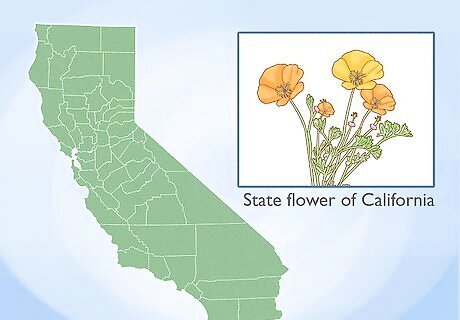
The poppy is the state flower of California. The bright orange blooms of the California poppy naturally grow all over the state, so it’s no surprise they’re the official flower of the Golden State. The bold blooms also perfectly represent the shining fields of gold that initially brought people into California.
Growing Poppies

Poppies grow best in full sun and well-draining soil. To grow poppies in your garden, find a spot that gets at least 6 hours of direct sunlight. Just sprinkle the seeds in the ground in the early spring and water them when the soil feels dry. Then, watch the bright blossoms bloom in mid-summer. Some poppy varieties are annuals, meaning they only live for 1 growing season, while others are perennials that grow back each year. Popular poppy flowers to grow are the California poppy, the Oriental poppy, and the Flanders poppy. In the US, poppies typically grow well in USDA hardiness zones 3 through 8.




















Comments
0 comment